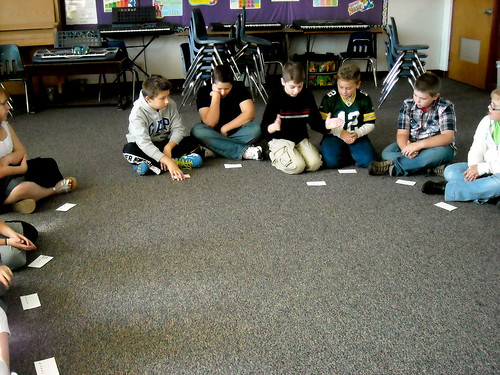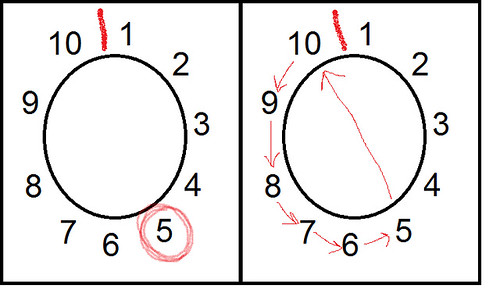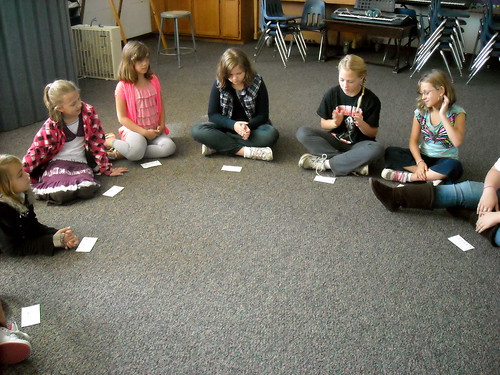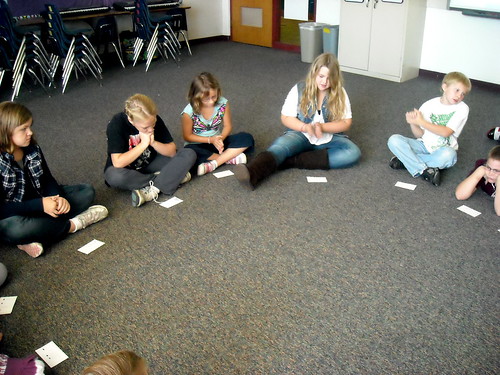Solution? New rhythm game using quarter notes, quarter rests, and eighth notes. Once students get good at the game I'll add in other harder rhythms and hopefully get us back onto track. I call this new rhythm game Rhythmic Concentration. It was based off of a music concentration that many of you probably have heard about.
Here is how it works:

Everyone in the class sits in a circle on the floor.

Each student is given a basic rhythm that was written on an index card. (I used only quarter notes, quarter rests, and eighth notes, however you could add in other rhythms your students know)
I then put a piece of tape or something to mark the 'beginning/end' of the circle. The person on the right of the marker is #1. The goal of the game is to be #1 at the end of the game.
The #1 person claps their rhythm and then #2 claps their rhythm immediately after. This continues all the way around the circle. During the first round, I normally just let them practice their rhythm. However, after that it gets harder.
Students continue clapping their rhythms as they continue around the circle. When someone misses their turn or hesitates that student has to go to the end (to the left of the marker). Their rhythm stays where it is and then students fill in the spaces. For example: if #5 of #10 misses their turn #10 shifts to #9; #9 shifts to #8; #8 shifts to #7; #7 shifts to #6; #6 shifts to #5; and #5 shifts to #10!
For those visual learners like myself, a model of the switch!:

After that it gets even more difficult. I start sending people to the end of the circle for clapping the wrong rhythm, not doing it in beat, and I have even added the metronome for some of my older students and they have to stay in beat.

My students really seem to like it. What I like most about it is it is fast paced, so those that get frustrated with waiting for everyone to get a turn don't feel that way during this game. I also like it because they are practicing their rhythms without feeling like they are practicing rhythms!

If you try this out, please let me know how it goes or any changes you made to make the game run smoother! Also feel free to ask me questions about it, I'll do my best to answer them. Have fun!
Ooo! I like this! I am going to try your game out since I am working on rhythms with my students right now too.
ReplyDeleteLast week I gave student groups 2 rhythms cards and they had to compose a body percussion pattern while using the rhythm I gave them. The next class they moved to composing using rhythm sticks instead. At the end, groups perform for each other and we practice proper concert etiquette!
Let me know how it works out!
DeleteI also work with popsicle sticks with some of my younger groups like you showed in your blog post. I really liked the pipe cleaner idea for the half notes and quarter rests. I never could figure out how to add in the half notes.
I also like the idea of them creating their own body percussion pattern to go along with a rhythm card. I think they would really enjoy that. Especially some of my sillier students. :)
Hi Brittany,
ReplyDeleteCould you explain again what happens when a student gets rhythm wrong? Where do they go? I know explained, but my brain is turned off right now or something!
No problem it is kind of tricky to think about, but once you figure it out it isn't too difficult.
DeleteImagine you have a circle of 10.
You should have some sort of marker in between person #1 and person #10. This signifies the 'beginning/end' of the circle.
When a student gets their rhythm wrong they then go to the 'end' of the circle.
So, if they were #5 they now take #10's spot and rhythm. Then there is a gap where #5 is so the ones that are higher numbers fill in the spaces. #10 becomes #9, #9 becomes #8, etc. Until #6 becomes #5. All the ones that have lower numbers than #5 stay where they are (since the goal is to be #1).
You could also play so that the person that got the rhythm 'wrong' is out... but in my experience that turns into certain kids purposely getting it wrong to just kind of 'chill'. That or the kids that really need the practice are the ones that get out and don't keep practicing.
I'll try to put together a visual of how the game works, because it is rather difficult to explain
I updated the post with a picture to kind of show what would happen if someone gets the rhythm wrong.
DeleteThis is very intriguing...but I am still having trouble getting exactly what you are prescribing. Would you be able to insert or post a video tutorial or example? Thank you!
ReplyDeleteThanks for the idea!! I really appreciate yours
ReplyDelete